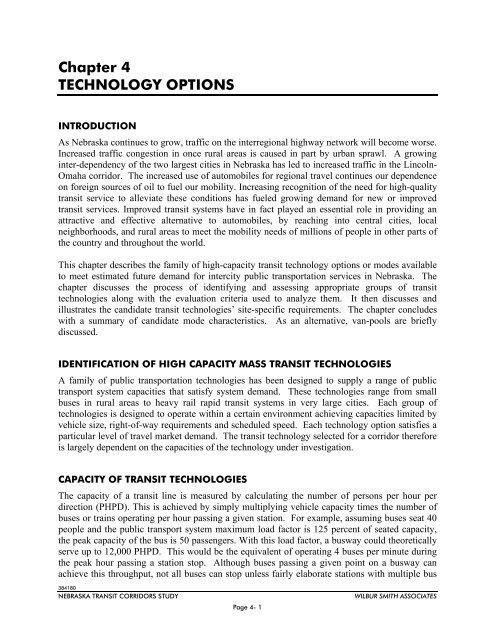NTRAC Final Study - Nebraska Department of Roads - State of ...
NTRAC Final Study - Nebraska Department of Roads - State of ...
NTRAC Final Study - Nebraska Department of Roads - State of ...
Create successful ePaper yourself
Turn your PDF publications into a flip-book with our unique Google optimized e-Paper software.
Chapter 4<br />
TECHNOLOGY OPTIONS<br />
INTRODUCTION<br />
As <strong>Nebraska</strong> continues to grow, traffic on the interregional highway network will become worse.<br />
Increased traffic congestion in once rural areas is caused in part by urban sprawl. A growing<br />
inter-dependency <strong>of</strong> the two largest cities in <strong>Nebraska</strong> has led to increased traffic in the Lincoln-<br />
Omaha corridor. The increased use <strong>of</strong> automobiles for regional travel continues our dependence<br />
on foreign sources <strong>of</strong> oil to fuel our mobility. Increasing recognition <strong>of</strong> the need for high-quality<br />
transit service to alleviate these conditions has fueled growing demand for new or improved<br />
transit services. Improved transit systems have in fact played an essential role in providing an<br />
attractive and effective alternative to automobiles, by reaching into central cities, local<br />
neighborhoods, and rural areas to meet the mobility needs <strong>of</strong> millions <strong>of</strong> people in other parts <strong>of</strong><br />
the country and throughout the world.<br />
This chapter describes the family <strong>of</strong> high-capacity transit technology options or modes available<br />
to meet estimated future demand for intercity public transportation services in <strong>Nebraska</strong>. The<br />
chapter discusses the process <strong>of</strong> identifying and assessing appropriate groups <strong>of</strong> transit<br />
technologies along with the evaluation criteria used to analyze them. It then discusses and<br />
illustrates the candidate transit technologies’ site-specific requirements. The chapter concludes<br />
with a summary <strong>of</strong> candidate mode characteristics. As an alternative, van-pools are briefly<br />
discussed.<br />
IDENTIFICATION OF HIGH CAPACITY MASS TRANSIT TECHNOLOGIES<br />
A family <strong>of</strong> public transportation technologies has been designed to supply a range <strong>of</strong> public<br />
transport system capacities that satisfy system demand. These technologies range from small<br />
buses in rural areas to heavy rail rapid transit systems in very large cities. Each group <strong>of</strong><br />
technologies is designed to operate within a certain environment achieving capacities limited by<br />
vehicle size, right-<strong>of</strong>-way requirements and scheduled speed. Each technology option satisfies a<br />
particular level <strong>of</strong> travel market demand. The transit technology selected for a corridor therefore<br />
is largely dependent on the capacities <strong>of</strong> the technology under investigation.<br />
CAPACITY OF TRANSIT TECHNOLOGIES<br />
The capacity <strong>of</strong> a transit line is measured by calculating the number <strong>of</strong> persons per hour per<br />
direction (PHPD). This is achieved by simply multiplying vehicle capacity times the number <strong>of</strong><br />
buses or trains operating per hour passing a given station. For example, assuming buses seat 40<br />
people and the public transport system maximum load factor is 125 percent <strong>of</strong> seated capacity,<br />
the peak capacity <strong>of</strong> the bus is 50 passengers. With this load factor, a busway could theoretically<br />
serve up to 12,000 PHPD. This would be the equivalent <strong>of</strong> operating 4 buses per minute during<br />
the peak hour passing a station stop. Although buses passing a given point on a busway can<br />
achieve this throughput, not all buses can stop unless fairly elaborate stations with multiple bus<br />
384180<br />
NEBRASKA TRANSIT CORRIDORS STUDY<br />
Page 4- 1<br />
WILBUR SMITH ASSOCIATES

















